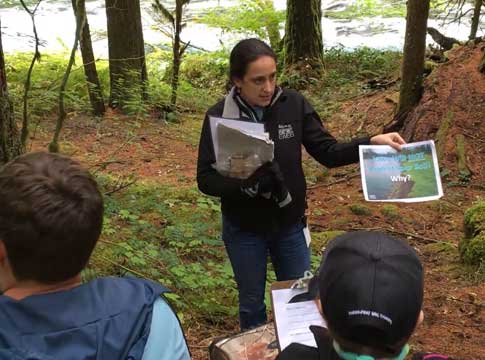Related News
Related News
-
Sustainability Snapshot - Celebrating Energy Efficiency Projects in the Community
Sustainability Snapshops highlight impactful projects completed by EWEB's Customer Solutions department, as a way to celebrate the meaningful work happening behind the scenes.
Find Out More -
McKenzie Valley electric service territory realignment study reaches key milestone
EWEB Commissioners approved a resolution authorizing the General Manager to negotiate and execute agreements with Lane Electric Cooperative regarding a potential realignment of electric service territory in the McKenzie Valley at the Board’s December meeting.
Find Out More -
Women in STEM: Meet the Hydro Project Engineer Building Habitat for Salmon
EWEB Engineer Associate Val Chang found her way to the McKenzie River from Los Angeles, inspired by heritage trips to the waters of Taiwan and key mentors along the way.
Find Out More -
Public Power Week Poster Contest Winners 2025
The results are in! View the winning posters from EWEB's 2025 Public Power Week Poster Contest.
Find Out More -
EWEB Hometown Heroes compete internationally
Out of 290 teams from 14 different countries, EWEB's Lineman Rodeo team places in the top third of competitors.
Find Out More -
EWEB's Halloween Truck-or-Treat is a huge success
Community members are accustomed to spotting EWEB trucks around Eugene streets and neighborhoods. But last week, those familiar vehicles looked a little different. At EWEB's second annual Truck-or-Treat Customer and Crew Appreciation Event, our fleet transformed into a festive Halloween spectacle.
Find Out More -
Let's Talk Turkey. Is your family ready for winter?
We're heading into the holidays, but that also means snow, ice, and not-so-nice weather might be in the forecast. Here are some tips to prepare in advance.
Find Out More -
Vote for your favorite Public Power Week Posters
The top five submittals will receive awards. Help us pick the winners.
Find Out More -
EWEB Hosts Annual Spill Drill to Protect McKenzie River
EWEB led emergency responders in its annual “spill drill” on the McKenzie River on Wednesday, Oct. 15, at the Trail Bridge Campground.
Find Out More -
Electric Projects underway in North & South Eugene
Underground lines and disaster-resilient power poles are part of EWEB’s infrastructure upgrade near Eugene’s largest natural resource area.
Find Out More -
EWEB general manager to retire in 2026
EWEB launches nationwide search for next leader to continue the progress of the last decade and ensure a smooth transition.
Find Out More -
Quartz Creek: Setting the Stage for Floodplain Restoration
The project resets the floodplain along 1.8 miles of a formerly channelized creek to improve water quality, fish habitat and natural disaster resiliency.
Find Out More -
You can’t predict the next disaster, but you can prepare
The earthquake lasted less than a minute. But now the power’s out. The tap runs dry. Cell service is spotty. Would you be ready?
Find Out More -
EWEB completes helicopter installation of salmon habitat features
EWEB adds downed trees and 2,000 tons of gravel to the Uupper McKenzie River below Tamolitch Falls to improve spawning habitat.
Find Out More -
Oregon’s New Utility Laws and How EWEB Customers Already Benefit from Fair, Transparent Rates
Oregon’s POWER Act and FAIR Energy Act target investor-owned utilities. Learn how EWEB’s local, community-owned model already meets these goals.
Find Out More - Show More
Salmon Watch Visits Carmen-Smith Spawning Channel
October 09, 2017

After an hour's ride up Highway 126, 30 excited middle school students spill from the bus steps and into the quiet of the upper McKenzie River watershed. Justin Demeter, McKenzie Watershed Council education coordinator and chairperson of the local Salmon Watch Steering Committee, greets the students and sets the stage for the time they will spend at EWEB's Carmen-Smith spawning channel.
"What you are about to experience is something so special, few people get the chance to experience it firsthand," Justin says. He states this at the beginning of each Salmon Watch field trip, and each time his sincerity is evident.
In the days leading up to the field trip, students have learned a little about the salmon life cycle and ecology and today they will witness the moment where the cycle both ends and begins again. Having journeyed for many months from the Pacific Ocean, adult Chinook salmon have arrived — at the location where they hatched — to lay their own eggs. After spawning, the salmon die, returning valuable nutrients to the freshwater ecosystem.
While at the spawning channel, the students rotate through four volunteer-led stations to gain a greater understanding and appreciation of salmon and the watershed.
On a short walk through the forest, along the river's edge, students consider the role the riparian area — or land next to a body of water — plays in a healthy watershed. They feel the soft thorns of the native nootka rose and imagine the path of a raindrop as it hits the the tree canopy, then the shrubs and smaller herbaceous plants, eventually making its way to the river.
On this particular day, Nancy Toth from EWEB's Source Protection Department brings her expertise and enthusiasm to the riparian station.
When asked why she commits her time to Salmon Watch, Nancy responds, "It's important we help the community stay connected to the watershed, not only to be good stewards for salmon and other wildlife, but in Eugene we rely on the McKenzie River for our drinking water as well."
Along the bank of the river, near the mouth of the channel, students gather around a table for the water quality station. Here, they test the water in the channel for pH, temperature, dissolved oxygen and turbidity. As they discuss the results the volunteer educator prompts them to draw conclusions around how the state of the riparian area might affect the water quality, and how both might affect the survival of the salmon. After a pause, someone throws out a partial answer, which another students builds on, and another, until as a group they develop a response.
Following the water quality station, the group moves on to fish biology where they focus on the star of the field trip. Walking along the channel wearing bright pink glasses glasses with polarized lenses to reduce the glare off the surface of the water, the students count salmon. About halfway up the channel, Kelly Reis from the Oregon Department of Fish and Wildlife points to a fish lying her on side using her tail to dig in the gravel.
"What do you think she's doing?" Kelly asks the students.
"Digging her redd," a few kids reply at once, seeming excited they know the terminology.
They continue walking, pointing out salmon to each other, until they reach the final station.
With the rush of the McKenzie as a backdrop, the students gather in front of small white basin containing river water, some debris and aquatic macroinvertebrates. The volunteer leading the station shows them how she collected the specimens by scrubbing the rocks along the the bed of the river, using a net to grab the small insects as they float downstream. The students begin poking in the water with plastic spoons and pipets, attempting to move each macroinvertebrate into a cell of an ice cube tray, after which they use a simple key to identify the species.
Watching the kids as they peer into the basins and try to figure out if what they have is a mayfly or a stonefly (it's almost always a mayfly), is a reminder of the power of experiential learning. A year from now they may not remember the details of what they learned today, but they might remember the spark of excitement they felt seeing that salmon dig her redd or the sense of discovery as they connected the concepts from one station to another.

